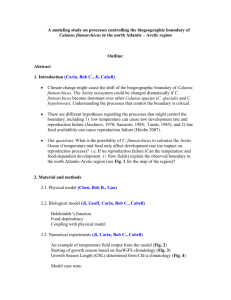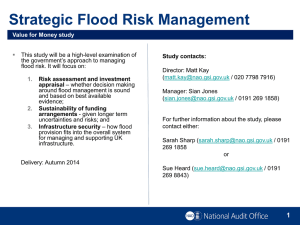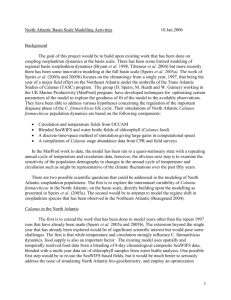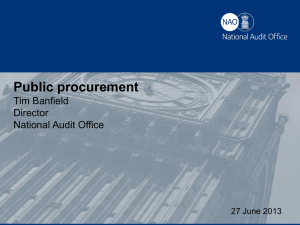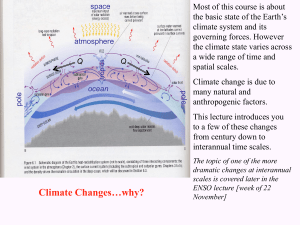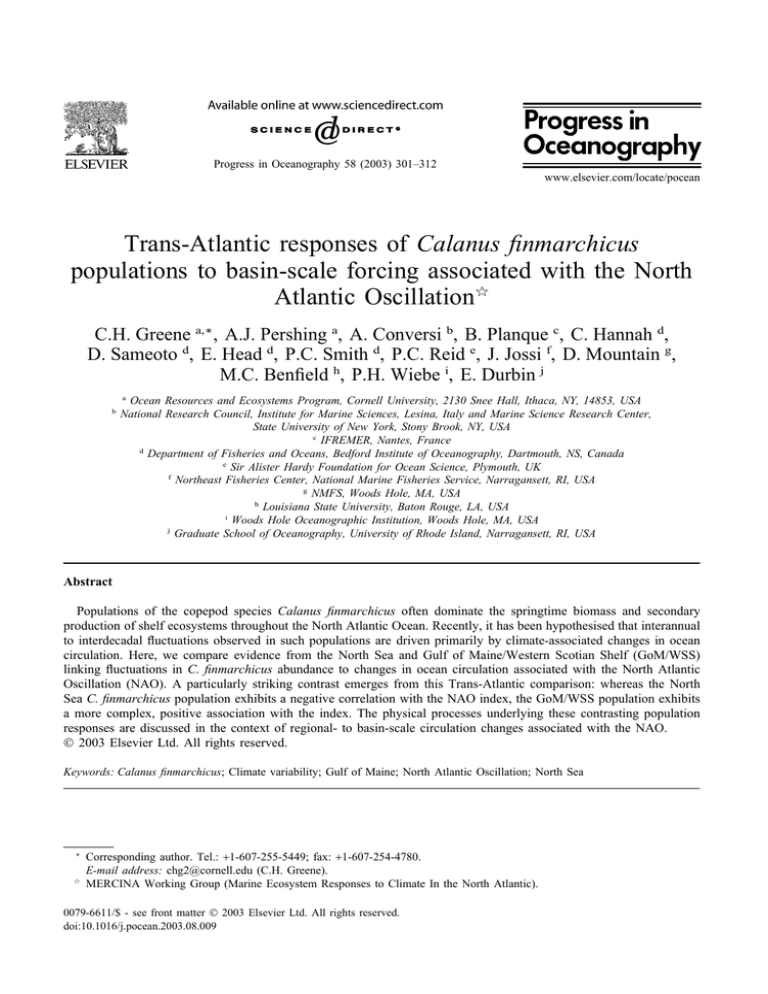
Progress in Oceanography 58 (2003) 301–312
www.elsevier.com/locate/pocean
Trans-Atlantic responses of Calanus finmarchicus
populations to basin-scale forcing associated with the North
Atlantic Oscillation夽
C.H. Greene a,∗, A.J. Pershing a, A. Conversi b, B. Planque c, C. Hannah d,
D. Sameoto d, E. Head d, P.C. Smith d, P.C. Reid e, J. Jossi f, D. Mountain g,
M.C. Benfield h, P.H. Wiebe i, E. Durbin j
b
a
Ocean Resources and Ecosystems Program, Cornell University, 2130 Snee Hall, Ithaca, NY, 14853, USA
National Research Council, Institute for Marine Sciences, Lesina, Italy and Marine Science Research Center,
State University of New York, Stony Brook, NY, USA
c
IFREMER, Nantes, France
d
Department of Fisheries and Oceans, Bedford Institute of Oceanography, Dartmouth, NS, Canada
e
Sir Alister Hardy Foundation for Ocean Science, Plymouth, UK
f
Northeast Fisheries Center, National Marine Fisheries Service, Narragansett, RI, USA
g
NMFS, Woods Hole, MA, USA
h
Louisiana State University, Baton Rouge, LA, USA
i
Woods Hole Oceanographic Institution, Woods Hole, MA, USA
j
Graduate School of Oceanography, University of Rhode Island, Narragansett, RI, USA
Abstract
Populations of the copepod species Calanus finmarchicus often dominate the springtime biomass and secondary
production of shelf ecosystems throughout the North Atlantic Ocean. Recently, it has been hypothesised that interannual
to interdecadal fluctuations observed in such populations are driven primarily by climate-associated changes in ocean
circulation. Here, we compare evidence from the North Sea and Gulf of Maine/Western Scotian Shelf (GoM/WSS)
linking fluctuations in C. finmarchicus abundance to changes in ocean circulation associated with the North Atlantic
Oscillation (NAO). A particularly striking contrast emerges from this Trans-Atlantic comparison: whereas the North
Sea C. finmarchicus population exhibits a negative correlation with the NAO index, the GoM/WSS population exhibits
a more complex, positive association with the index. The physical processes underlying these contrasting population
responses are discussed in the context of regional- to basin-scale circulation changes associated with the NAO.
2003 Elsevier Ltd. All rights reserved.
Keywords: Calanus finmarchicus; Climate variability; Gulf of Maine; North Atlantic Oscillation; North Sea
∗
夽
Corresponding author. Tel.: +1-607-255-5449; fax: +1-607-254-4780.
E-mail address: chg2@cornell.edu (C.H. Greene).
MERCINA Working Group (Marine Ecosystem Responses to Climate In the North Atlantic).
0079-6611/$ - see front matter 2003 Elsevier Ltd. All rights reserved.
doi:10.1016/j.pocean.2003.08.009
302
C.H. Greene et al. / Progress in Oceanography 58 (2003) 301–312
Contents
1.
Introduction . . . . . . . . . . . . . . . . . . . . . . . . . . . . . . . . . . . . . . . . . . . . . . . . . . . . . . . . . 302
2.
Trans-Atlantic patterns in C. finmarchicus abundance and the NAO . . . . . . . . . . . . . . . . . . . . . . . 302
3.
Basin- and regional-scale changes in climate, ocean circulation, and the NAO . . . . . . . . . . . . . . . . . 304
4. Population responses of C. finmarchicus to changes in ocean circulation . . . . . . . . . . . . . . . . . . . . . 306
4.1. The North Sea . . . . . . . . . . . . . . . . . . . . . . . . . . . . . . . . . . . . . . . . . . . . . . . . . . . . . . 306
4.2. The Gulf of Maine/Western Scotian Shelf region . . . . . . . . . . . . . . . . . . . . . . . . . . . . . . . . . 307
5.
Discussion . . . . . . . . . . . . . . . . . . . . . . . . . . . . . . . . . . . . . . . . . . . . . . . . . . . . . . . . . . 310
1. Introduction
Calanus finmarchicus dominates the zooplankton biomass found throughout the cold temperate and subpolar oceanic waters of the North Atlantic Ocean (Raymont, 1983; van der Spoel & Heyman, 1983; Mauchline, 1998). Although considered an oceanic species, C. finmarchicus frequently achieves high levels of
abundance in many North Atlantic shelf ecosystems. For example, although not self-sustaining, expatriate
populations of C. finmarchicus dominate the springtime biomass and secondary production in the shelf
ecosystems of the North Sea, the Northeast Atlantic, and Gulf of Maine/Western Scotian Shelf (GOM/WSS)
region of the Northwest Atlantic. Since these expatriate shelf populations must be replenished every year
or every few years by advection from some oceanic source (Longhurst, 1998), it has been hypothesised
that their interannual to interdecadal fluctuations in abundance are driven primarily by climate-associated
changes in ocean circulation (Greene & Pershing, 2000). Such fluctuations in the abundance of C. finmarchicus have been documented in the North Sea and attributed to changes in ocean circulation patterns associated with the North Atlantic Oscillation (NAO) (Reid, Planque, & Edwards, 1998; Stephens, Jordan,
Taylor, & Proctor, 1998; Heath, Backhaus, Richardson, McKenzie, Slagstad, Gallego et al., 1999). More
recently, fluctuations in abundance observed in the GOM/WSS region also have been linked to NAOassociated changes in ocean circulation (Greene and Pershing, 2000; Conversi, Piontkovski and Hameed,
2001; MERCINA, 2001). Here, we compare these trans-Atlantic responses of C. finmarchicus to basinscale NAO forcing and document how regional- to basin-scale changes in ocean circulation account for
the striking differences observed in the population ecology of this species in shelf ecosystems on both
sides of the North Atlantic.
2. Trans-Atlantic patterns in C. finmarchicus abundance and the NAO
The North Sea population of C. finmarchicus has exhibited a general decline in abundance since the
early 1970s (Fig. 1a). This negative trend has been observed in the Irish Sea and shelf waters north and
west of Scotland and Ireland as well (Fromentin & Planque, 1996; Planque & Taylor, 1998). In contrast,
the GoM population of C. finmarchicus increased from relatively low levels of abundance during the 1960s
to very high levels of abundance during the 1980s (Fig. 1b) (Jossi & Goulet, 1993; Greene & Pershing,
2000). This positive trend halted abruptly in 1990. From 1991 to 1994, the abundance levels of C. finmarchicus in the GoM were an order of magnitude lower than those observed during the 1980s and comparable
to levels observed during the 1960s. A brief increase in the population occurred during the mid-1990s, but
C.H. Greene et al. / Progress in Oceanography 58 (2003) 301–312
303
Fig. 1. Time series of C. finmarchicus abundance from (a) the North Sea and (b) the Gulf of Maine/Scotian Shelf region. Time
series are based on Continuous Plankton Recorder (CPR) data collected for C. finmarchicus from the North Sea since the late 1940s
and from the Gulf of Maine/Scotian Shelf region since the late 1950s. Data from the Gulf of Maine are indicated by circles and
from the Scotian Shelf by triangles. Methods of sample collection and processing have been described by Hardy (1939); Colebrook
(1975), and Jossi and Goulet (1993). (c) Time series of the NAO index from 1955 to 1999. The NAO index is the mean difference,
expressed as an anomaly from the long-term mean, in atmospheric pressure during winter between the subtropical high pressure
system of the North Atlantic, measured in Lisbon, Portugal, and the subpolar low pressure system, measured in Stykkisholmur,
Iceland (Hurrell, 1995). (d) Cross-correlation analyses between C. finmarchicus abundance and the NAO index. Results of the analyses
of data from the North Sea are indicated by rectangles and from the Gulf of Maine during 1961–1989 and 1961–1999, respectively
by triangles and circles. (e) Regression between C. finmarchicus abundance in the North Sea and the NAO index with no time lag.
(f) Regression between C. finmarchicus abundance in the Gulf of Maine and the NAO index with a time lag of 4 years, 1961–1989
(dashed) and 1961–1999 (continuous).
this was followed by another decline to extremely low levels in 1998. The abundance levels of C. finmarchicus on the WSS largely mirrored those observed in the GoM for the periods of 1961–1975 and 1991–1994
(Fig. 1b); however, the brief resurgence of the GoM population during the mid-1990s was not observed on
the WSS (Sameoto, 2001). Unfortunately, a gap in the time series from the WSS does not allow comparisons
during the critical decade of the 1980s, when the C. finmarchicus population in the GoM exhibited its
highest abundance.
Relationships between C. finmarchicus abundance trends in these ecosystems and the NAO can be examined by comparing the above time series with a time series of the NAO index (Fig. 1c). A cross-correlation
304
C.H. Greene et al. / Progress in Oceanography 58 (2003) 301–312
analysis between the abundance of C. finmarchicus in the North Sea and the NAO index reveals a strong
negative correlation, with little evidence for a time lag exceeding 1 year (Fig. 1d and e). In contrast, a
similar cross-correlation analysis between C. finmarchicus abundance in the GoM and the NAO index
reveals a weak positive correlation from 1961 to 1989, with evidence for a time lag of approximately 4
years (Fig. 1d and f). However, this correlation breaks down and becomes non-significant when data from
the 1990s are included (Fig. 1d and f). To reconcile these contrasting population responses, it is necessary
to examine how basin-scale changes in climate and ocean circulation associated with different phases of
the NAO manifest themselves in physical and biological processes at the regional scale.
3. Basin- and regional-scale changes in climate, ocean circulation, and the NAO
The phase of the NAO has important effects on climate throughout the North Atlantic. During positive
phases, the planetary westerly winds intensify, and the North Atlantic storm track shifts to the north. These
changes lead to milder conditions in the western Atlantic and east coast of the United States; colder,
stormier conditions in the northwest Atlantic and Greenland; and milder conditions in the northeast Atlantic
and coasts of northern Europe and Great Britain (Hurrell, 1995; Dickson, Lazier, Meincke, Rhines, &
Swift, 1996). In contrast, during negative phases of the NAO, the westerly winds diminish in intensity and
the storm track shifts to the south. These changes lead to colder, stormier conditions in the western Atlantic
and east coast of the United States; milder conditions in the northwest Atlantic and Greenland; and colder,
drier conditions in the northeast Atlantic and coasts of northern Europe and Great Britain (Hurrell, 1995;
Dickson, Lazier, Meincke, Rhines & Swift, 1996).
The phase of the NAO also has important effects on the formation and spreading of deep water, as well
as the near-surface circulation patterns of the North Atlantic. In the subpolar northwest Atlantic, during
positive phases, convection is deeper and more intense in the Labrador Sea; a relatively cool, fresh, and
thick layer of Labrador Sea Water is formed and volume transport in the Deep Western Boundary Current
increases, while volume transport in the shallow baroclinic component of the Labrador Current decreases
(Fig. 2a) (Dickson, Lazier, Meincke, Rhines & Swift, 1996; Dickson, 1997; Curry, McCartney, & Joyce,
1998; Loder, Shore, Hannah, & Petrie, 2001). In the subpolar northeast Atlantic, convection during positive
phases of the NAO is shallower and weaker in the Greenland Sea; the deep-water layers are warmer,
saltier, and thinner; and the formation and volume transports of Greenland Sea Deep Water and Norwegian
Fig. 2. Ocean circulation responses to (a) positive and (b) negative phases of the NAO. Areas with increased deep convection and
water mass formation are darkly shaded; those with decreased deep convection and water-mass formation are lightly shaded. Water
masses and currents are labeled as follows: GSDW, Greenland Sea Deep Water; LC, Labrador Current; LSW, Labrador Sea Water.
C.H. Greene et al. / Progress in Oceanography 58 (2003) 301–312
305
Sea Deep Water decrease (Fig. 2a) (Dickson, Lazier, Meincke, Rhines & Swift, 1996; Dickson, 1997).
When the phase of the NAO reverses to negative, these patterns of convection and deep-water formation
in the Labrador and Greenland Seas also reverse (Fig. 2b). Hence, convection becomes shallower and
weaker in the Labrador Sea, the Labrador Sea Water layer becomes warmer, saltier and thinner, and volume
transport in the Deep Western Boundary Current decreases while volume transport in the near-surface
baroclinic component of the Labrador Current increases (Dickson, Lazier, Meincke, Rhines & Swift, 1996;
Dickson, 1997; Curry, McCartney & Joyce, 1998; Loder, Shore, Hannah & Petrie, 2001). Synchronous
with the above events in the Labrador Sea, convection becomes deeper and more intense in the Greenland
Sea; the deep-water layers are cooler, fresher, and thicker; and the formation and volume transports of
Greenland Sea Deep Water and Norwegian Sea Deep Water increase (Dickson, Lazier, Meincke, Rhines &
Swift, 1996; Dickson, 1997). The deep, intense convection observed in the Greenland Sea during negative
phases of the NAO is mirrored by shallow, intense ventilation in the western Sargasso Sea and increased
formation and spreading of 18° Mode Water (Dickson, Lazier, Meincke, Rhines & Swift, 1996).
Interactions between the major western boundary currents of the subpolar and subtropical gyres have
also been linked to the NAO (Rossby & Benway, 2000; Loder, Shore, Hannah & Petrie, 2001). Associated
with these NAO-linked gyral interactions are changes in the Coupled Slope Water System (CSWS) of the
Northwest Atlantic (Pickart, McKee, Torres and Harrington, 1999; MERCINA, 2001). During positive
phases of the NAO, the CSWS tends to operate in its maximum modal state, with relatively warm and
salty Atlantic Temperate Slope Water (ATSW) taking a position adjacent to the shelf break and forming
a front near the mouth of the Gulf of St. Lawrence with Labrador Subarctic Slope Water (LSSW) (Fig.
3a) (MERCINA, 2001). This advance of ATSW coincides with a decrease in shallow Labrador Current
transport around the Tail of the Grand Banks and an enhanced hydrographic signature of Labrador Sea
Water in the Deep Western Boundary Current (Pickart, McKee, Torres & Harrington, 1999). When the
phase of the NAO reverses to negative, the CSWS typically shifts to its minimum modal state (Fig. 3b).
This mode is characterised by relatively cool and fresh LSSW advancing along the shelf break as far to
the southwest as the Middle Atlantic Bight (MERCINA, 2001). This advance of LSSW along the shelf
break displaces the warmer, saltier ATSW further offshore and coincides with an increase in shallow
Labrador Current transport around the Tail of the Grand Banks and a reduced hydrographic signature of
Labrador Sea Water in the Deep Western Boundary Current (Pickart, McKee, Torres & Harrington, 1999).
Fig. 3. Modes of the Coupled Slope Water System: (a) maximum mode; (b) minimum mode. Circled numbers indicate 1997–1998
advance of LSSW frontal boundary along the continental margin: (1) September 1997; (2) January 1998; (3) February 1998; (4)
August 1998. Water masses and currents are labelled as follows: ATSW, Atlantic Temperate Slope Water; GS, Gulf Stream; LSSW,
Labrador Subarctic Slope Water.
306
C.H. Greene et al. / Progress in Oceanography 58 (2003) 301–312
4. Population responses of C. finmarchicus to changes in ocean circulation
4.1. The North Sea
The changes in climate and ocean circulation patterns associated with the NAO provide a context for
interpreting the contrasting population responses of C. finmarchicus on the two sides of the North Atlantic.
The response of this species in the North Sea has been attributed to several physical mechanisms associated
with the NAO, each operating on a different time scale (Fig. 4). The first of these mechanisms involves
year-to-year fluctuations of advective transport into the North Sea. Positive NAO years are characterised
by an increased inflow of relatively warm upper-layer water from the North Atlantic into the North Sea
(Fig. 4) (Reid, Borges, & Svendsen, 2001a). This increased inflow of warmer North Atlantic water is
hypothesised to supply the North Sea with fewer recruits of C. finmarchicus from the oceanic habitat where
they diapause during autumn and winter (Hirche, 1996). It also provides a less favourable environment
for growth and reproduction of this cold-water species (Fromentin & Planque, 1996). In contrast, negative
NAO years are characterised by an increased inflow of relatively cool deep water from the Norwegian Sea
into the North Sea (Fig. 4) (Reid, Borges & Svendsen, 2001a). This increased inflow of cooler water is
hypothesised to supply the North Sea with an increased number of recruits from the oceanic diapause
habitat and provide the population with cooler, more favourable conditions for growth and reproduction.
Both of these advection-based hypotheses provide reasonable explanations for the strong negative correlation between the abundance of C. finmarchicus in the North Sea and the NAO index (Fig. 1d and e)
(Planque & Reid, 1998), as well as the general decline in abundance of the species observed there since
the early 1970s (Fig. 1a) (Fromentin & Planque, 1996; Planque & Taylor, 1998; Reid, Planque &
Edwards, 1998).
Additional mechanisms have been proposed that link abundance patterns of C. finmarchicus in the North
Sea to longer-term changes in ocean circulation associated with the NAO. One of these mechanisms
involves changes in regional deep-water circulation. Heath et al. (1999) hypothesised that the main source
of late copepodites in diapause that recruits to the North Sea shelf in spring occurs at depths greater than
Fig. 4. NAO-associated changes in ocean circulation patterns thought to affect C. finmarchicus abundance in the North Sea. The
first mechanism involves year-to-year fluctuations in advective transport into the North Sea. Positive NAO years are characterised
by an inflow of relatively warm water from the North Atlantic into the North Sea. Negative NAO years show an inflow of relatively
cool water from the Norwegian Sea. A second mechanism involves changes in deep-water circulation. During negative NAO conditions, the production and transport of Norwegian Sea Deep Water (NSDW) increases, leading to an increased flux of this water
mass across the Iceland-Scotland Ridge through the Faroe-Shetland Channel (FSC). The third mechanism involves an intensification
of a jet at the shelf edge, which transports warm water into the vicinity of the British Isles and North Sea.
C.H. Greene et al. / Progress in Oceanography 58 (2003) 301–312
307
600 m in the Faroe-Shetland Channel. During the predominantly positive NAO conditions of the past
quarter century (Hurrell, Kushnir, & Visbeck, 2001), the production and transport of Norwegian Sea Deep
Water has steadily declined, leading to a reduced flux of this water mass across the Iceland-Scotland Ridge
through the Faroe-Shetland Channel (Fig. 4) (Hansen, Turrell, & Osterhus, 2001). These changes in deepwater circulation have been hypothesised to reduce the supply of late copepodites available for recruitment
into the North Sea, further augmenting the decline in the abundance of C. finmarchicus observed there in
recent years.
Another proposed mechanism involves the intensification of the slope current, which transports warm
water into the vicinity of the British Isles and the North Sea (Fig. 4) (Reid, Holliday, & Smyth, 2001b).
Reid, Borges and Svendsen (2001a) hypothesised that several years of highly positive NAO conditions
during the late 1980s and early 1990s were necessary to intensify the flow of this shelf edge jet. Since
the jet advects both warm water and warm-water species into the region, it has resulted in a regime shift
that is unfavourable to C. finmarchicus (Reid et al., 2001a,b). As in the previous case, this mechanism
would further augment the recent declining trend in the abundance of C. finmarchicus observed in the
North Sea.
Although each of the mechanisms described above would tend to reinforce the declining trend in C.
finmarchicus abundance in the North Sea, the longer-term mechanisms may interact with the annual one
to complicate year-to-year predictability. For example, Planque and Reid (1998) found that their predictions
of the abundance of C. finmarchicus in the North Sea, based on a regression with the NAO index, proved
accurate through most of the CPR time series until the mid-1990s. A pronounced drop in the NAO index
during the winter of 1996 led them to predict a year of high C. finmarchicus abundance after a steady
decline through the early part of the decade. This predicted increase did not occur, and one explanation
may be that a single-year drop in the NAO index, even as in this case the largest drop of the century, may
not be sufficient to overcome the effects of changing circulation patterns that were years in the making.
4.2. The Gulf of Maine/Western Scotian Shelf region
The more complex, positive association between C. finmarchicus in the GoM/WSS region and the NAO
index has also been attributed primarily to advective–supply mechanisms (Greene and Pershing, 2000;
MERCINA, 2001). These mechanisms, suggested after recent observations emerged from the Global Ocean
Ecosystem Dynamics (GLOBEC) Northwest Atlantic/Georges Bank Field Programme, link fluctuations in
C. finmarchicus abundance to NAO-triggered modal shifts in the northwest Atlantic’s CSWS. In the section
that follows, we will first describe the events observed during the years of the GLOBEC Field Programme,
then place these observations in the context of relevant time-series data collected over the past half century.
The drop of the century in the NAO index during the winter of 1996 led to a modal shift in the CSWS,
an intensification of the shallow baroclinic component of the Labrador Current around the Tail of the Grand
Banks, and the most extensive intrusion of LSSW into the GoM/WSS region since the 1960s (MERCINA,
2001). This cooler, fresher LSSW steadily advanced along the Scotian Shelf break and replaced or significantly altered the deep basin waters of the WSS and GoM over the subsequent 2 years (Fig. 3b). By the
early autumn of 1998, all of the warmer, saltier ATSW, typical of the GoM deep basins since the 1970s,
had been replaced by LSSW or rendered significantly cooler and fresher through mixing. Coinciding with
this major advective event and change in the regional hydrography, C. finmarchicus exhibited an orderof-magnitude decline in abundance in the GoM during 1998 (Fig. 5). The NAO index returned to positive
values after the winter of 1996, and by December 1999 the LSSW had been replaced in most of the WSS
and GoM deep basins by ATSW (MERCINA, 2001). Again, coincident with the physical changes, C.
finmarchicus in the GoM/WSS region during December 1999 returned to a level comparable to that
observed before the dramatic decline of 1998 (Fig. 5).
The oceanographic events observed in the Northwest Atlantic during the latter part of the 1990s provide
308
C.H. Greene et al. / Progress in Oceanography 58 (2003) 301–312
C. finmarchicus C5 Integrated Abundance
8
Georges Basin
Jordan Basin
Wilkinson Basin
6
Abundance (#m
-2
4
x 10 )
7
5
4
3
2
1
no data
0
October
December
1997
October
December
1998
October
December
1999
Fig. 5. Depth-integrated abundance of C. finmarchicus fifth copepodites sampled in the deep basins of the Gulf of Maine during
the autumns of 1997 to 1999. One night-time MOCNESS sample was collected from each basin on each of the five cruises. Abundances
from samples taken in Georges Basin are indicated by circles, those from Jordan Basin by squares, and from Wilkinson Basin by
triangles. Mean values from all basins during a given year are indicated by a diamond with bars corresponding to ±1 SE.
an important piece of the puzzle for interpreting the historical abundance of C. finmarchicus in the
GoM/WSS region over the past half century. During the decade of the 1960s, the NAO index was predominantly negative and the CSWS operated in its minimum modal state (Fig. 6) (MERCINA, 2001). This was
an unusual period during the past 50 years when the deep waters of the GOM/WSS region were derived
primarily from cool and fresh LSSW (Loder et al., 2001; MERCINA, 2001) and numbers of C. finmarchicus
were relatively low (Greene and Pershing, 2000; MERCINA, 2001). Subsequent to the 1960s, the NAO
index shifted to a predominantly positive phase and the CSWS to its maximum modal state (Fig. 6).
Associated with these changes, the deep waters of the GoM/WSS region became warmer and saltier, derived
primarily from ATSW, and C. finmarchicus numbers increased significantly. These coincident increases in
the NAO index and C. finmarchicus account for the significant positive correlation observed between them
during the period of 1961–1989 (Greene & Pershing, 2000). In the context of these long-term trends, the
events of the late 1990s fit the pattern consistently: the NAO index dropped dramatically during the winter
of 1996, the coupled slope water system shifted from its maximum to minimum modal state during 1997,
and C. finmarchicus abundance declined by an order of magnitude during 1998.
The puzzle is more complicated than this, however. Although the CSWS typically undergoes modal
shifts in response to large phase changes in the NAO index, the time lag of the response and the intensity
of the phase change necessary to elicit a response (i.e. threshold effect) appear to be variable. After the
1960s, the coupled slope water system shifted from its maximum to minimum modal state on only a few
brief occasions, including 1981–1983, 1988–1991, and 1996–1998 (Fig. 6) (MERCINA, 2001). While the
1996–1998 modal shift was clearly in response to the large phase change in the NAO index during the
C.H. Greene et al. / Progress in Oceanography 58 (2003) 301–312
309
Normalized
Abundance
RSWT Index
NAO Index
Time Series from the Gulf of Maine Region
a. Winter NAO Index
3
0
-3
b. Regional Slope Water Temperature Index
4
0
-4
c. Gulf of Maine C. finmarchicus Abundance
1
0
-1
1950
1955
1960
1965
1970
1975
Year
1980
1985
1990
1995
2000
Fig. 6. Time series from the North Atlantic. (a) Annual values of the winter NAO index. (b) Annual values of the Regional Slope
Water Temperature index. (c) Annual values of the Calanus finmarchicus abundance index in the GoM. Positive anomalies in each
of the time series are lightly shaded and negative anomalies darkly shaded. Lines connecting the figures are offset by the time lags
determined in the cross-correlation analyses. The NAO index is defined in the caption to Fig. 1. The Regional Slope Water Temperature
index was developed as an indicator of the modal state of the CSWS, with positive (negative) values corresponding to maximum
(minimum) modal state conditions (MERCINA, 2001). It is the dominant mode derived from a principal component analysis of eight
slope–water temperature–anomaly time series from the GoM/WSS region. The Calanus finmarchicus abundance index is the mean
abundance anomaly for this species calculated each year as the mean difference between log-transformed observed abundances and
log-transformed expected abundances (MERCINA, 2001). Expected abundances were determined from the climatological mean seasonal cycle of C. finmarchicus in the Gulf of Maine. These abundance index values, connected by the solid line, have been calculated
differently from the abundance values shown here and in Fig. 1b as circles. Those values were calculated by the standardised
procedures described by Colebrook (1975) and therefore are comparable to other values presented in the literature. The abundance
index values displayed only in this figure are valuable in that they can be used to fill in gaps in the time series when data are
insufficient to meet the SAHFOS standards.
winter of 1996, the circumstances leading up to the modal shifts in the early and late 1980s are less clear.
Both of these modal shifts were weaker than the one observed in the late 1990s. In addition, although both
of them occurred within a few years of a positive to negative phase change in the NAO index, the time
lag in each case was different (Fig. 6) (MERCINA, 2001). We conclude from analyses of these time-series
data that, although physical responses of the CSWS are significantly correlated with the NAO index, a
large proportion of the variance in the relationship remains unexplained as a result of variable time lags
and potential threshold effects (MERCINA, 2001). This conclusion is consistent with the weak positive
correlation observed between C. finmarchicus abundance in the GoM and the NAO index from 1961 to
1989, a relationship that subsequently became non-significant when data from the 1990s were included
(Fig. 1d and f).
While retrospective analyses of the time series data yield correlative relationships that are informative,
they provide few details of the underlying physical and biological processes linking population responses
of C. finmarchicus in the GoM with NAO-associated modal shifts in the CSWS. We hypothesise that
springtime incursions of slope water onto the WSS play a central role in linking the two. Head, Harris
and Petrie (1999) have shown that slope-water incursions can be an important source of C. finmarchicus
310
C.H. Greene et al. / Progress in Oceanography 58 (2003) 301–312
recruiting to the WSS. Since the major inflows into the GoM from the WSS also occur during spring
(Smith, Houghton, Fairbanks & Mountain, 2001), the timing is right for these incursions of slope water
to affect the advective supply of C. finmarchicus into the GoM.
There are several potential mechanisms that could explain the relationship between the modal state of
the CSWS and C. finmarchicus in the GoM/WSS region. During the minimum modal state of the CSWS,
LSSW advances southwestward along the WSS, displacing ATSW offshore (Fig. 3b). If the abundance of
C. finmarchicus is lower in LSSW than in ATSW, then source waters with reduced abundance of this
species could provide a simple explanation for the regional decline of C. finmarchicus during minimum
modes of the CSWS. We are unaware of any evidence supporting this hypothesis at present. An alternative
hypothesis is that cross-frontal exchange is impeded by intensification of the slope-water front during
minimum modal conditions, reducing the frequency and/or intensity of slope-water incursions. Pickart,
McKee, Torres and Harrington (1999) provided evidence that the gradient of this front is intensified during
minimum modal conditions; however, we are unaware of any observations confirming that the frequency
and/or intensity of slope-water incursions are reduced under these conditions. Clearly, future field studies
will be necessary to fill in the gaps in our knowledge.
5. Discussion
We have reviewed evidence from the North Sea and GoM/WSS linking fluctuations in the abundance
of C. finmarchicus to changes in ocean circulation associated with the NAO. A noteworthy finding of this
review is the regional dependence of the population responses of C. finmarchicus. In the North Sea, the
species exhibits a negative correlation with the NAO index, whereas the GoM/WSS population exhibits a
more complex, positive association with the index. Since ocean–circulation responses to the NAO vary in
different regions of the North Atlantic, it should come as no surprise that the population responses of C.
finmarchicus vary by region as well.
The responsiveness of C. finmarchicus to changes in ocean circulation, combined with its ecological
importance throughout the North Atlantic, makes this species a good indicator of climate change and a
suitable target species for global climate-change research (GLOBEC, 1991; MERCINA, 2001). While this
review has focused primarily on linking regional population responses of C. finmarchicus to circulation
changes associated with the NAO, our findings are also relevant to predicting the future responses of the
species to global climate change.
During the past quarter century, the NAO index has exhibited a persistently increasing trend, a trend
that some have associated with greenhouse warming (Hurrell, Kushnir & Visbeck, 2001) and the recently
documented rise in oceanic heat content (Hoerling, Hurrell, & Xu, 2001; Barnett, Pierce, & Schnur, 2001;
Levitus et al., 2001). While we have shown that positive NAO conditions appear unfavourable for C.
finmarchicus in the North Sea and favourable in the GoM/WSS region, the increased climate variability
predicted by some models as a consequence of rising greenhouse-gas concentrations (IPCC, 2001) makes
long-term predictability difficult at present. The NAO has exhibited unusual behaviour during the latter
half of the 1990s, including a shift in the subpolar low-pressure centre towards the Greenland Sea
(Ulbrich & Christoph, 1999). Several investigators have suggested that rising greenhouse-gas concentrations
may be responsible for this unusual behaviour (Langenberg, 2000). In addition, the extreme drop of the
NAO index during 1996 may represent an unusual event or perhaps a sign of the larger swings in climate
that we might expect in a greenhouse future. The uncertainty surrounding these recent events also raises
the issue of what we might expect if the NAO were to enter a long, persistently negative phase. Palaeoclimate records indicate that such conditions have occurred in the past (Appenzeller, Stocker, & Anklin, 1998;
Jones, Osborn, & Briffa, 2001), and some investigators have suggested that we might expect a return to
such conditions in a greenhouse future (Wood, Keen, Mitchell & Gregory, 1999; Hillaire-Marcel, de Vernal,
C.H. Greene et al. / Progress in Oceanography 58 (2003) 301–312
311
Bilodeau, & Weaver, 2001). Ultimately, the fate of C. finmarchicus populations on both sides of the North
Atlantic will depend on how regional circulation patterns respond to natural, as well as anthropogenically
forced changes in global climate.
Acknowledgements
We thank the organisers for the opportunity to present this paper at the 70th Anniversary Symposium
of the CPR survey held in Edinburgh, Scotland. This paper is contribution #341 from the US GLOBEC
NW Atlantic/Georges Bank Programme, with support provided by the NOAA Coastal Ocean Programme
and the NSF Biological Oceanography Programme. The manuscript was prepared while Charles H Greene
was in residence as a sabbatical fellow at the National Center for Ecological Analysis and Synthesis, a
Center funded by NSF (Grant #DEB-0072909) and the University of California, Santa Barbara.
References
Appenzeller, C., Stocker, T. F., & Anklin, M. (1998). North Atlantic Oscillation dynamics recorded in Greenland ice cores. Science,
282, 446–448.
Barnett, T. P., Pierce, D. W., & Schnur, R. (2001). Detection of anthropogenic climate change in the world’s oceans. Science, 292,
270–274.
Colebrook, J. M. (1975). Continuous Plankton Recorder survey: automatic data processing methods. Bulletin of Marine Ecology, 8,
123–142.
Conversi, A., Piontkovski, S., & Hameed, S. (2001). Seasonal and interannual dynamics of Calanus finmarchicus in the Gulf of
Maine (Northeastern US shelf) with reference to the North Atlantic Oscillation. Deep-Sea Research II, 48, 519–530.
Curry, R. G., McCartney, M. S., & Joyce, T. M. (1998). Oceanic transport of subpolar climate signals to mid-depth subtropical
waters. Nature, London, 388, 575–577.
Dickson, R. (1997). From the Labrador Sea to global change. Nature, London, 386, 649–650.
Dickson, R., Lazier, J., Meincke, J., Rhines, P., & Swift, J. (1996). Long-term coordinated changes in the convective activity of the
North Atlantic. Progress in Oceanography, 38, 241–295.
Fromentin, J. M., & Planque, B. (1996). Calanus and environment in the eastern North Atlantic. II. Influence of the North Atlantic
Oscillation on C. finmarchicus and C. helgolandicus. Marine Ecology Progress Series, 134, 111–118.
GLOBEC (1991). Global Ocean Ecosystem Dynamics: Northwest Atlantic Program. US GLOBEC Report No 2. Washington, DC:
Joint Oceanographic Institutions.
Greene, C. H., & Pershing, A. J. (2000). The response of Calanus finmarchicus populations to climate variability in the Northwest
Atlantic: Basin-scale forcing associated with the North Atlantic Oscillation (NAO). ICES Journal of Marine Science, 57,
1536–1544.
Hansen, B., Turrell, W. R., & Osterhus, S. (2001). Decreasing overflow from the Nordic seas into the Atlantic Ocean through the
Faeroe Bank Channel since 1950. Nature, London, 411, 927–930.
Hardy, A. C. (1939). Ecological investigations with the Continuous Plankton Recorder. Object, plan, and methods. Hull Bulletins of
Marine Ecology, 1, 1–57.
Head, E. J. H., Harris, L. R., & Petrie, B. (1999). Distribution of Calanus spp. on and around the Nova Scotia Shelf in April—
evidence for offshore source of Calanus finmarchicus to the mid- and western regions. Canadian Journal of Fisheries and Aquatic
Science, 56, 2463–2476.
Heath, M. R., Backhaus, J. O., Richardson, K., McKenzie, E., Slagstad, D., Gallego, A., Madden, H., Mardaljevic, J., Hainbucher,
D., Schacht, A., Jónasdóttir, S., Beare, D., Dunn, J., & Hay, S. (1999). Climate fluctuations and the spring invasion of the North
Sea by Calanus finmarchicus. Fisheries Oceanography, 8, 163–176.
Hillaire-Marcel, C., de Vernal, A., Bilodeau, G., & Weaver, A. J. (2001). Absence of deep-water formation in the Labrador Sea
during the last interglacial period. Nature, London, 410, 1073–1077.
Hirche, H. J. (1996). Diapause in the marine copepod, Calanus finmarchicus—a review. Ophelia, 44, 129–143.
Hoerling, M. P., Hurrell, J. W., & Xu, T. (2001). Tropical origins for recent North Atlantic climate change. Science, 292, 90–92.
Hurrell, J. W. (1995). Decadal trends in the North Atlantic Oscillation: regional temperatures and precipitation. Science, 269, 676–679.
Hurrell, J. W., Kushnir, Y., & Visbeck, M. (2001). The North Atlantic Oscillation. Science, 291, 603–605.
312
C.H. Greene et al. / Progress in Oceanography 58 (2003) 301–312
IPCC. (2001). Climate Change 2001: The Scientific Basis. Contribution of Working Group I to the Third Assessment Report of the
Intergovernmental Panel on Climate Change (IPCC). Cambridge, UK: Cambridge University Press.
Jones, P. D., Osborn, T. J., & Briffa, K. R. (2001). The evolution of climate over the last millennium. Science, 292, 662–667.
Jossi, J. W., & Goulet, J. R. (1993). Zooplankton trends: US north-east shelf ecosystem and adjacent regions differ from north-east
Atlantic and North Sea. ICES Journal of Marine Science, 50, 303–313.
Langenberg, H. (2000). Oscillating opinion. Nature, London, 408, 924–925.
Levitus, S., Antonov, J. I., Wang, J., Delworth, T. L., Dixon, K. W., & Broccoli, A. J. (2001). Anthropogenic warming of the earth’s
climate system. Science, 292, 267–270.
Loder, J. W., Shore, J. A., Hannah, C. G., & Petrie, B. D. (2001). Decadal-scale hydrographic and circulation variability in the
Scotia-Maine region. Deep-Sea Research II, 48, 3–35.
Longhurst, A. R. (1998). Ecological geography of the sea. San Diego, CA: Academic Press.
Mauchline, J. (1998). The biology of calanoid copepods. San Diego, CA: Academic Press.
MERCINA. (2001). Oceanographic responses to climate in the Northwest Atlantic. Oceanography, 14, 76–82.
Pickart, R. S., McKee, T. K., Torres, D. J., & Harrington, S. A. (1999). Mean structure and interannual variability of the slopewater
system south of Newfoundland. Journal of Physical Oceanography, 29, 2541–2558.
Planque, B., & Reid, P. C. (1998). Predicting Calanus finmarchicus abundance from a climatic signal. Journal of the Marine Biological
Association of the United Kingdom, 78, 1015–1018.
Planque, B., & Taylor, A. H. (1998). Long-term changes in zooplankton and the climate of the North Atlantic. ICES Journal of
Marine Science, 55, 644–654.
Raymont, J. E. G. (1983). Plankton and productivity in the oceans, 2nd edn, vol. 2. Zooplankton. Oxford, UK: Pergamon Press.
Reid, P. C., Borges, M. D., & Svendsen, E. (2001a). A regime shift in the North Sea circa 1988 linked to changes in the North Sea
fishery. Fisheries Research, 50, 163–171.
Reid, P. C., Holliday, N. P., & Smyth, T. J. (2001b). Pulses in the eastern margin current and warmer water off the north west
European Shelf linked to North Sea ecosystem changes. Marine Ecology Progress Series, 215, 283–287.
Reid, P. C., Planque, B., & Edwards, M. (1998). Is observed variability in the long-term results of the Continuous Plankton Recorder
survey a response to climate change? Fisheries Oceanography, 7, 282–288.
Rossby, T., & Benway, R. L. (2000). Slow variations in mean path of the Gulf Stream east of Cape Hatteras. Geophysical Research
Letters, 27, 117–120.
Sameoto, D. (2001). Decadal changes in phytoplankton color index and selected calanoid copepods in Continuous Plankton Recorder
data from the Scotian Shelf. Canadian Journal of Fisheries and Aquatic Science, 58, 749–761.
Smith, P. C., Houghton, R. W., Fairbanks, R. G., & Mountain, D. G. (2001). Interannual variability of boundary fluxes and water
mass properties in the Gulf of Maine and on Georges Bank: 1993–1997. Deep-Sea Research I, 48, 37–70.
Stephens, J. A., Jordan, M. B., Taylor, A. H., & Proctor, R. (1998). The effects of fluctuations in North Sea flows on zooplankton
abundance. Journal of Plankton Research, 20, 943–956.
Ulbrich, U., & Christoph, M. (1999). A shift in the NAO and increasing storm track activity over Europe due to anthropogenic
greenhouse gas forcing. Climate Dynamics, 15, 551–559.
van der Spoel, S., & Heyman, R. P. (1983). A comparative atlas of zooplankton: biological patterns in the oceans. Berlin:
Springer-Verlag.
Wood, R. A., Keen, A. B., Mitchell, J. F. B., & Gregory, J. M. (1999). Changing spatial structure of the thermohaline circulation
in response to atmospheric CO2 forcing in a climate model. Nature, London, 399, 572–575.

